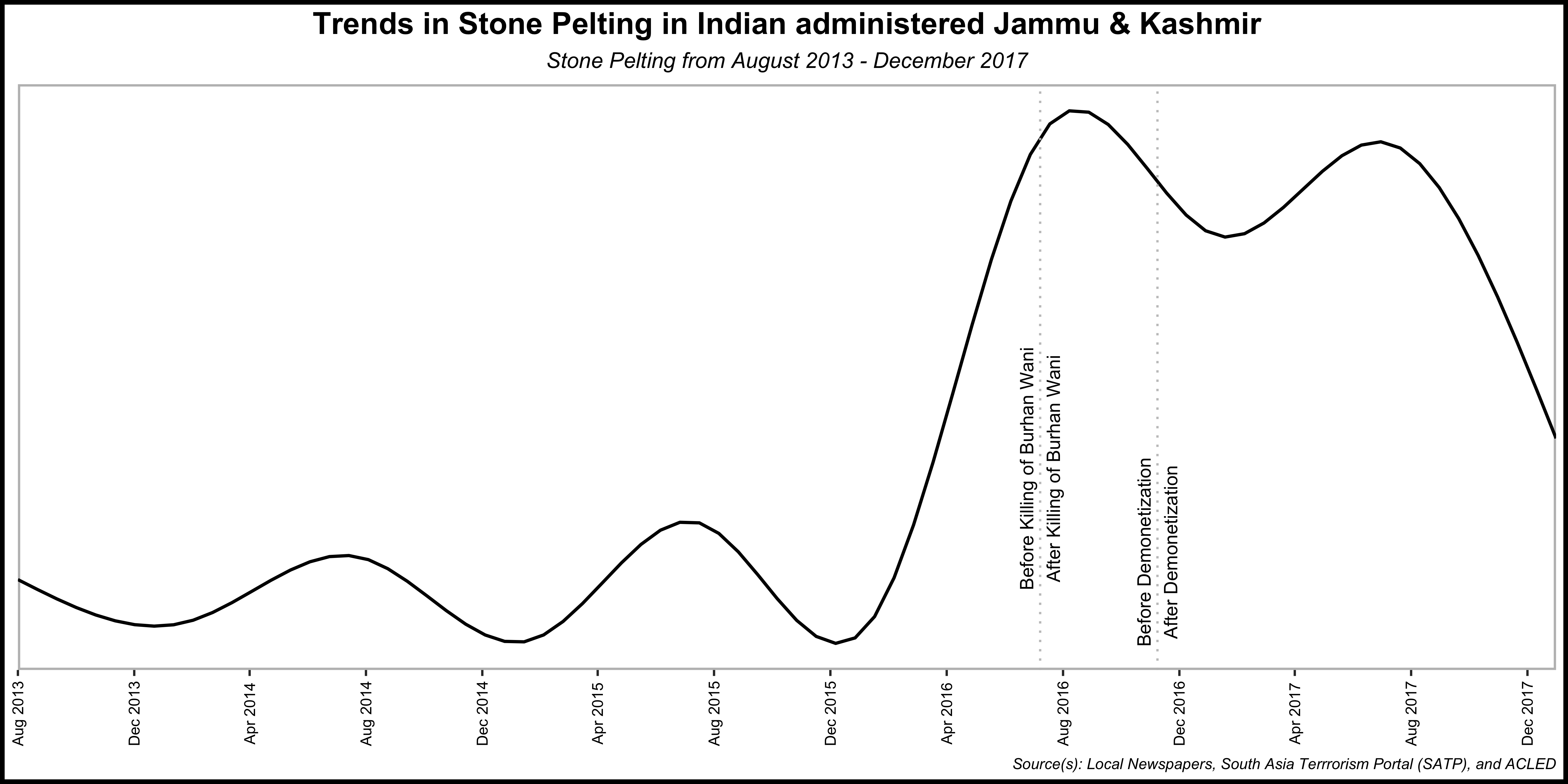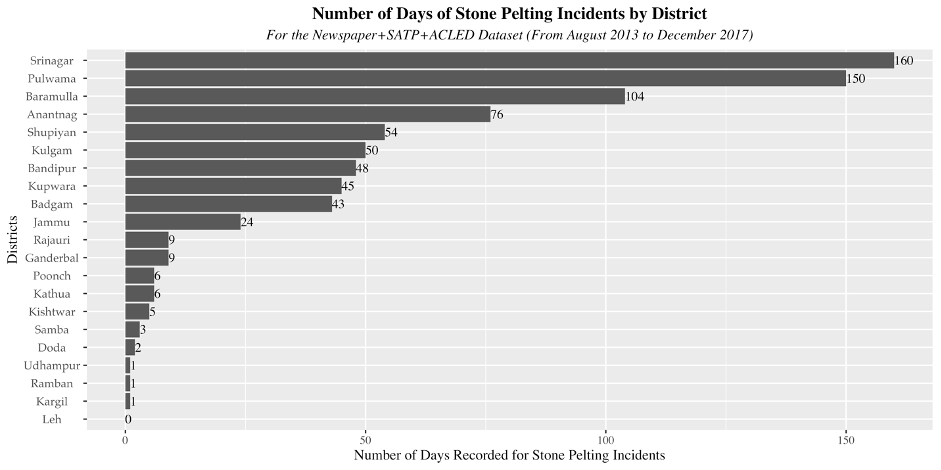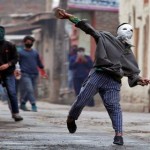On 9 April 2017, Major Gogoi, an Indian Army officer with the 53 Rashtriya Rifles, stationed in Srinagar, garnered accolades at home and criticism abroad when he bound a young Muslim Kashmir man, Farooq Ahmed Dar, to his jeep to shield his forces from stone-pelting protestors. According to Gogoi, he received a distress call from an Indo-Tibetan Police (ITBP) team alerting him that some 1,200 persons had surrounded the ITBP personnel as well as polling staff in the Utligam polling station (40 km from Srinagar) during the violence-marred by polls for the Lok Sabha. The incident again cast a dubious light upon India’s handling of the terrorism and insurgency plaguing the Union Territory (then a State) and gave its state and non-state foes alike fodder for their anti-India information operations.
Stone pelting has become an iconographic means to protest the Indian government in Kashmir since 2008.[1] While scholars and activists often characterise stone-throwing as a form of non-violent protest,[2] the tactic has killed and injured many civilians as well as security forces in Kashmir.[3] One popular explanation for the increasing stone-throwing tactic by Kashmiri youth has been financial support from Pakistan’s notorious intelligence agency, the Inter-Services Intelligence directorate (ISI). In 2016, after the death of a young and popular militant leader, Burhan Wani, Indian intelligence claimed that Pakistan was paying Kashmiri youth Rs. 500 to throw stones as part of the Rs. 100 crore ($13.6 million) that the organisation expended in the past year to fuel violence in Jammu and Kashmir.[4] In 2017, captured stone-pelters confessed that the ISI paid them some Rs. 5,000 to 7,000 ($68-$95) per month in addition to clothes to throw stones at security forces.[5] Moreover, the Indian Army asserted that “83% of all youth who become militants start with throwing stones for Rs. 500 and therefore needed to be stopped.”[6]
Motivated in considerable measure by these narratives about Pakistani-sponsored violence in Kashmir, on 8 November 2016, the Indian government rendered 86% of the nation’s currency valueless overnight in what was known as demonetisation.[7] The government defended this move on several grounds including a desire to nudge the country towards greater digitisation, to enervate the black market, and to disable Pakistan-supported violence. The government oddly claimed success in the latter objective despite robust evidence against it: 2018 was in fact the deadliest year in a decade.[8]
Even more puzzling is that many Indians, who otherwise denounce the policy, believe that it curbed violence in Kashmir despite evidence to the contrary. A nationally-representative survey of 2,100 respondents found that more than 70% believed that demonetisation “played an important role in curbing terrorism as it has dealt a huge blow to the funding of terror in states like Jammu & Kashmir as well as left-wing extremist violence across several states’ even while the same survey evinced respondent doubts that the policy achieved its other objectives.[9]
There is very little room for doubt that Pakistan sponsors various kinds of violence in Kashmir and elsewhere in India, and it is most likely true that some stone-throwers are compensated. But it is unlikely that all do so because of Pakistani remuneration or that these payments are their only or primary motivation.[10] While the truth lies somewhere between India’s maximalist claims of Pakistani culpability and Pakistan’s blanket claims of innocence, Kashmiris are caught in the middle.
To assess Delhi’s assertion that demonetisation curbed stone-throwing in Kashmir, we assembled a novel district-level dataset of daily stone-pelting events between 1 August 2013 and 31 December 2017, along with other explanatory variables that may account for stone-pelting, such as: opportunity costs, weather factors, whether the day is Friday or whether the day occurs during Ramazan, whether the district is rural or urban, and whether the district is comprised mostly of Muslims or non-Muslims.
Because of the enduring nature of this conflict, we limited our scope of inquiry to 1 August 2013 through 31 December 2017. Expanding this timeline would necessitate controlling for major events in India and Pakistan bilateral relations as well as significant developments in relations between J&K and the central government. We also sought to limit our scope of inquiry to one year after demonetisation because we presume that Pakistan—sooner rather than later—developed counter-measures to thwart the demonetisation policy even though we are dubious about India’s claims on the salience of this factor.
Since our extensive efforts to find extant data – which included filing multiple Right to Information requests – foundered, per force, we assembled a novel dataset of stone-pelting events for this study using three different sources including: data from the Armed Conflict Location and Event Data (ACLED) which included 603 stone-pelting incidents over 532 observations; the South Asian Terrorism Portal (SATP) included 357 stone-pelting incidents spanning 239 observations; as well as a manual search of four Kashmir-based, English-language dailies (i.e. Daily Excelsior, Greater Kashmir, Kashmir Observer and Kashmir Times) for stone-pelting occurrences, which yielded 126 observations of stone-pelting. Note that we ensured that no event was double counted. Our final dataset contained 797 observations of stone-throwing from August 1, 2013 until December 31, 2017 which we depict timewise in Figure 1 and district-wise in Figure 2.

Source: In-house tabulation of data

Source: In-house tabulation of data
While one may be tempted to simply analyse the trend lines in Figure 1 and look at the quantum of stone-pelting events before and after the policy of demonetisation, such an exercise would not be adequate. After all, increases or decreases in stone pelting could be caused by unusual weather trends (temperature and precipitation), the occurrence of Ramazan, features of the districts (urban/rural, population composition), economic opportunity costs imposed by stone pelting and possible subsequent arrest, or a combination of some or all of these variables. Thus, to accurately discern the impact of this policy upon stone-pelting we must also control for other factors that likely influence the occurrence of stone pelting. The best methodology for this is regression analyses wherein our dependent variable is the occurrence of stone pelting on a given day in a given district and our control variables include whether or not the data on stone pelting falls before or after demonetisation as well as district averages for the aforenoted controls. We also ran similar models wherein we controlled for the killing of Burhan Wani on 8 July 2016 which catalysed considerable unrest.[11]
Additionally, because we could not estimate the binary variables for demonetisation and Wani’s death simultaneously, we estimated the same model (Equation 3) using three different time periods to disentangle the effects of demonetisation policy and Wani’s death. The first period is before Wani’s killing (1 August 2013 until 8 July 2016). The second period is after his death but before demonetisation was enacted (9 July 2016 until 9 November 2016). The third period is after the demonetisation policy was enacted (10 November 2016 to 31 December 2017).[12]
In none of these models do we find any empirical support for the Indian government’s claim that demonetisation reduced stone-pelting; rather, we found that stone-pelting increased after demonetisation even after controlling for other confounding factors such as temperature, precipitation, economic opportunity costs, and demographics of the district among other variables. Stone pelting also increased after Wani’s demise, all other variables held constant. We also found that stone-pelting was most common in urban, more densely populated, Muslim-dominant districts; on Fridays and during Ramazan; and on warmer days, all else constant. This is generally consistent with expectations about target density and the roles of Friday prayer and possibly Ramazan in both decreasing the organisational cost of mobilisation but also the opportunity costs of doing so.
The most illuminating variable is our proxy for economic opportunity costs of stone-pelting (the price of onions). The Indian government justified demonetisation by the assertion that Pakistan instigated unrest by paying stone-throwers daily and monthly sums as well as clothes and other in-kind goods. Prior to Wani’s killing, people seemed sensitive to opportunity costs. If the Pakistanis were inundating the region with significant amounts of cash, we should not expect to observe this sensitivity. After Wani’s death and prior to the onset of demonetisation, opportunity costs correlate with stone-pelting consistent with the possibility that people are so enraged that they simply do not care about the economic repercussions of protesting.
As noted above, we also ran regressions having divided the sample into the three periods. In the third period, corresponding to the post-demonetisation period which lasted 13 months, we find no relationship between opportunity costs and stone-pelting with other variables accounting for the observed variation in stone pelting. In this period, if the government’s claims about Pakistani support were valid on a large scale, we should have seen a negative correlation between onion prices and stone-pelting because the large notes purportedly supplied by Pakistan were now useless.
Understanding the real impact of demonetisation upon stone pelting is important for several reasons. Indians who believe this narrative that all disturbances in the troubled state are an artifact of Pakistani manipulation necessarily view Kashmiri discontent as illegitimate despite the various sources of data that attest to sustained grievances among Kashmiri Muslims, particularly in the valley.[13] The official discourse depicts Kashmiris as “misguided youth” who are “guided by remote control from across the border” and “working under a well-thought-out long-term plan of Pakistan to create a situation where people would not participate in any election in the future.”[14] Prime Minister Modi himself, while addressing an audience in Srinagar in November 2019, has described the stone pelters as “misguided youths who are under the influence of false propaganda from a foreign power” and elaborated that “every stone or weapon picked up by the youth of this state is only meant to destabilise their own state.”[15]
Such characterisations render the stone-pelters the primary obstacle to development and democratisation in the state rather than state failures and as such there is no concomitant moral requisite to engage Kashmiris on the sources of their disaffection. Consequently, this characterisation of the stone pelters and their motivations shrinks any political space throughout India to consider their grievances within any constitutional or political framework.
Christine Fair is a Visiting Scholar, Gateway House. She is an assistant professor at Georgetown University’s Security Studies Program in the Edmund A. Walsh School of Foreign Service.
This essay was exclusively written for Gateway House: Indian Council on Global Relations. You can read more exclusive content here.
For interview requests with the author, or for permission to republish, please contact outreach@gatewayhouse.in.
©Copyright 2021 Gateway House: Indian Council on Global Relations. All rights reserved. Any unauthorized copying or reproduction is strictly prohibited.
References:
[1] Parthasarathy, Malini. 2010. “Understanding Kashmir’s Stone-pelters.” The Hindu, August 4. https://www.thehindu.com/opinion/lead/Understanding-Kashmirs-stone-pelters/article16120870.ece.
[2] Pressman, Jeremy. “Throwing stones in social science: Non-violence, unarmed violence, and the first intifada.” Cooperation and Conflict 52, no. 4(2017): 519-536. doi.org/10.1177/0010836717701967.
[3] There are no comprehensive and/or reliable estimates available. In 2018, the Union Minister of State for Home Hansraj Ahir informed the upper house (Rajya Sabha) that between 2015-2017, there were 4,799 stone-pelting incidents in which 17 protestors and two security personnel were killed. However, this report doesn’t indicate whether the protestors were killed by the stone-pelting or by the security forces themselves (Rajya Sabha, Government of India, Ministry of Home Affairs. “Unstarred Question No-556.” Answered on February 7, 2018. https://rajyasabha.nic.in/rsnew/Questions/QResult.aspx; “4,799 stone- pelting incidents in J-K in 2015-17; 19 killed.” 2018. Financial Express, February 7. https://www.financialexpress.com/india-news/4799-stone-pelting-incidents-in-j-k-in-2015-17-19-killed/1056631/.
[4] Bhalla, Abhishek. 2016. “Pakistan funded terrorism in Jammu and Kashmir.” India Today, July 15. https://www.indiatoday.in/mail-today/story/pakistan-funds-terror-jammu-and-kashmir-isi-hafiz-saeed-329312-2016-07-15.
[5] Pathak, Sushant and Jamshed Adil Khan. 2017.“Stone-pelters on Hire in Kashmir.” India Today, March 29. https://www.indiatoday.in/india/story/jammu-and-kashmir-stone-pelters-hizbul-mujahideen-burhan-wani-968402-2017-03-29.
[6]“‘Stone-pelters today, terrorists tomorrow’: Army’s grim message to J-K.” 2019. Hindustan Times, August 2. https://www.hindustantimes.com/india-news/stone-pelters-of-today-terrorists-of-tomorrow-army-s-message-to-j-k-moms/story-GIIaco5YGjqx7Tus9rllEL.html.
[7] Doshi, Vidhi. 2016.“Cash for queues: people paid to stand in line amid India’s bank note crisis.” The Guardian, November 27. https://www.theguardian.com/world/2016/nov/28/india-bank-lines-controversy-cash-for-queuing.
[8] Slater, Joanna and Ishfaq Naseem. 2018. “2018 is the deadliest year in a decade in Kashmir.” The Washington Post, December 23. https://www.washingtonpost.com/world/asia_pacific/2018-is-the-deadliest-year-in-a-decade-in-kashmir-next-year-could-be-worse/2018/12/22/493ff2e4-03bb-11e9-958c-0a601226ff6b_story.html.
[9] Das, Prajanma. 2019.“De-mon-niversary: 70% Indians think demonetisation helped control terror, says study.” Edex Live, November 8. https://www.edexlive.com/news/2019/nov/08/demonetization-anniversary-digital-india-jk-terror-fund-8982.html.
[10] Ganie, Mohd Tahir. “‘All I got is stones in my hand’: youth-led stone pelting protests in Indian-administered Kashmir.” Social Movement Studies 20, no. 1 (2021): 115-123.
[11] For more details see C. Christine Fair, Digvijay Ghotane & Parina Patel (2021) Did India’s demonetization policy curb stone-pelting in Indian-administered Kashmir, Small Wars & Insurgencies, published online May 25, 2021. https://www.tandfonline.com/doi/abs/10.1080/09592318.2021.1915678.
[12] For more details see C. Christine Fair, Digvijay Ghotane & Parina Patel (2021) Did India’s demonetization policy curb stone-pelting in Indian-administered Kashmir, Small Wars & Insurgencies, published online May 25, 2021. https://www.tandfonline.com/doi/abs/10.1080/09592318.2021.1915678.
[13] International Crisis Group. “Raising the Stakes in Jammu and Kashmir, Report 310.” August 5, 2020. https://www.crisisgroup.org/asia/south-asia/kashmir/310-raising-stakes-jammu-and-kashmir.
[14] Sahay, Mohan. 2017. “Kashmir politics: Not a stone’s throw away.” Economic Times, May 5. https://economictimes.indiatimes.com/blogs/et-commentary/kashmir-politics-not-a-stones-throw-away/
[15] “Modi in Srinagar: Every stone picked by misguided youth hurts Kashmir.” 2019. Business Standard, November 21, 2019. https://www.business-standard.com/article/politics/modi-in-srinagar-every-stone-picked-by-misguided-youth-hurts-kashmir-118051900607_1.html.


